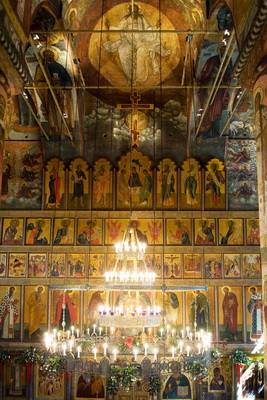The Iconostasis, as a habitual element of the Orthodox Church, appeared relatively recently, slightly more than six centuries ago. In the times of early Orthodox Christianity in Russia, altar screens in Eastern Christian churches were relatively low. These screens most commonly consisted of several columns with an architrave resting atop. In the lower part between the columns were screen plates. Fragments of such stone screens (columns, architraves and plates) can be found in early churches in Kiev and Chernigov. But because most of the altar screens in Russia were made of wood, only traces of their junctions with the walls, pillars and the floors have survived (such as, for example, in the St. Sophia Cathedral in Novgorod).
The idea of screening the altar space in the church appeared as late as the first centuries of Christianity. The earliest mentions of the choir screen date back to the 4th century AD. The choir screen of that time was meant to separate the sanctuary of a Christian church from the nave and restrict access to it for the secular but at the same time not to hide it completely from the prayers’ eyes. First orders dating back to the 11th century contain instructions to cover the altar area with curtains during a liturgy. Gradually, throughout the 12th – early 15th centuries, intercolumniation (spacing between columns) was filled with icons and fresco-paintings. Development of the solid altar screen was closely associated with theological pursuits and accompanied the changes in the liturgy practice. Owing to the lack of strict rules regulating the design of altar screens they varied in shapes in different areas of the Byzantine oecumene. The main elements of the structure were the Beautiful Gates in the center above which the deesis icons were often placed (such as, for example, the 12th century icon of Emmanuel with Angels from the Tretyakov Gallery collection). The evidence of pursuits of the optimal form of the solid altar screen are stone screens, frequently encountered in 14th century Moscow architecture. The stone plane of this screen usually broke down into small pillars and culminated in a small eave – thus, their appearance imitated a traditional column screen. Atop the barrier a row of icons could be placed.
The appearance of the high iconostasis in Russia is commonly associated with metropolitan Cyprian (1390-1406) and his efforts to unify liturgical practice. Even the first iconostases of this type are marked for consistent structure and strict logic of icon arrangement. This pattern would soon become canonic and widespread across Russia.
Originally, the iconostasis included a full-length Deesis with the Virgin Mary, John the Baptist, supreme archangels and apostles with the icon of Christ in Majesty at the center. The icons of martyrs, festival and prophet rows were sometimes added to the iconostasis. A great contribution to the development of the canonic iconostasis should be credited to Andrei Rublev, who created multi-tier iconostases in the Cathedral of Annunciation in the Moscow Kremlin, Cathedral of the Assumption in Vladimir and the Trinity Cathedral at the Trinity-St.Sergius Lavra.
In the second half of the 16th century the forefather row was added to the iconostasis. Now the iconostasis consisted of two, three, four or five tiers. Between the 15th and 17th centuries classical in Russia were full-scheme, i.e. four or five tier iconostases.
The first iconostasis that has survived in fragments was painted in 1408 for the Cathedral of Dormition in Vladimir by Andrei Rublev and Daniil Cherny. It consisted of four tiers amongst which the Deesis row was bigger in size and slightly advanced itself into the naos, thus emphasizing its special role compared to other rows. This iconostasis did not cover the subcupola columns but divided them into parts. The Vladimir iconostasis served as an example for the 1481 iconostasis in the Dormitory Cathedral of the Moscow Kremlin and the 1497 iconostasis in the Dormitory Cathedral of the Monastery of St. Cyril of Belozersk.
Between 1425 and 1427 the first closed (not divided by subrcupola columns) iconostasis was created in the Trinity Cathedral at the Trinity-St.Sergius Monastery. This work was commissioned by hegumen Nikon to Andrei Rublev and Daniil Cherny, but this time they worked along with their disciples and assistants who did most of the painting – this can be felt in different painting styles.
A full-length prophet row was first added to the full-length Deesis and festival rows in the early 16th century in the St. Sophia Cathedral in Novgorod, it is significantly higher than the festival tier.
Some four-tier iconostases culminated in the Holy Mandylon icon, such as, for instance, the iconostasis of the Transfiguration Cathedral in the Solovetsky Monastery. The location of the icon above the fourth prophet row was obviously a prerequisite for the appearance of the next fifth tier. The earliest five-tier iconostasis (1598) which survives in a rebuilt form today, is in the Smolensk Cathedral at the Novodevichy Monastery. Apart from the local saints, it also represents a full-length Deesis, the prophet and forefather rows. The dominating role of the Deesis row in this five-tier iconostasis is subordinate to the later-developed prophet’s and forefather rows, thus diminishing the Old Testament’s conceptions they express.

